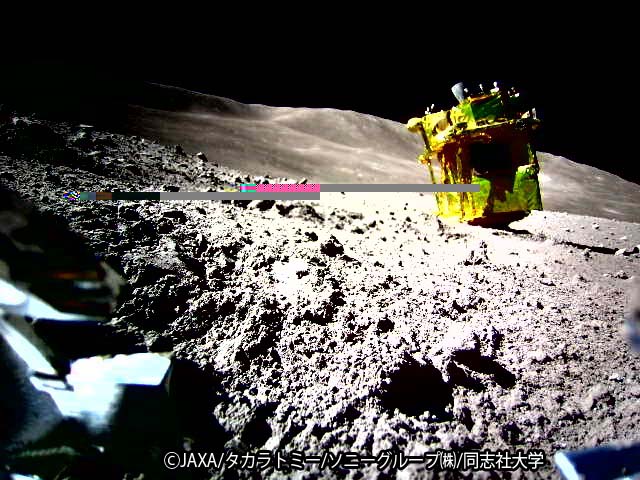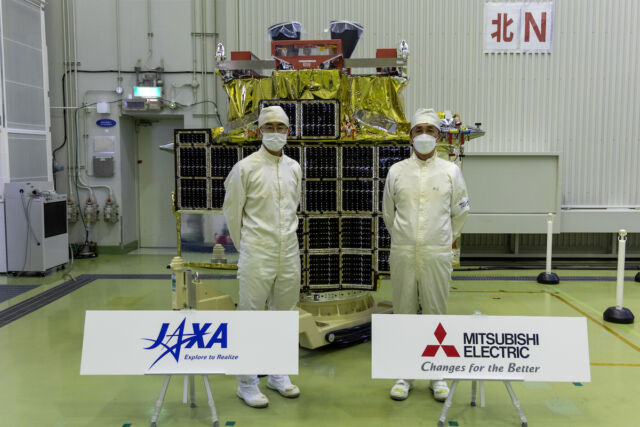
Japan's SLIM spacecraft is seen nose down on the surface of the Moon.
JAXA/Takara Tomy/Sony Group Corporation/Doshisha University
Japan's first lunar lander made an unsteady touchdown on the Moon last week, moments after one of its two main engines inexplicably lost power and apparently fell off the spacecraft, officials said Thursday.
About the size of a small car, the Small Lander for Investigating Moon (SLIM) landed on Friday, making Japan the fifth country to achieve a soft landing on the lunar surface. Shortly after landing, ground teams in Japan realized the spacecraft was not recharging its battery with its solar panels. The evidence at the time suggested that SLIM likely ended up in an unexpected orientation on the Moon, with its solar cells facing away from the Sun.
With the benefit of six days of data crunching and analysis, officials from the Japan Aerospace Exploration Agency (JAXA) briefed reporters Thursday on what they have learned about SLIM's landing. Indeed, the spacecraft toppled over after touching down, with its nose planted into the lunar regolith and its rear propulsion section pointed toward space.
It turns out that SLIM overcame a lot to get to that point. In the final minute of Friday's descent, one of SLIM's two engines failed, leaving the craft's sole remaining engine to bring the spacecraft in for an off-balance landing. Still, JAXA officials said the spacecraft achieved nearly all of its primary objectives. The roughly $120 million robotic mission made the most pinpoint landing on the Moon in history, just as it set out to do.
"From the spacecraft, we were able to acquire all the technical data related to navigation guidance leading to landing, which will be necessary for future pinpoint landing technology, as well as navigation camera image data during descent and on the lunar surface," JAXA said in a statement.
One of two tiny robots released by SLIM just before landing relayed a remarkable image of the lander standing upside down a short distance away. This might be the first close-up view of a crash landing, however gentle, on another world.
One plucky bird
Based on the update JAXA released Thursday, it's extraordinary that SLIM made it to the surface in one piece.
After launching in September and arriving at the Moon in December, SLIM lined up for a final descent to the lunar surface on Friday. Around 20 minutes before landing, the spacecraft ignited its two hydrazine-fueled rocket engines for a braking maneuver to drop out of lunar orbit.
JAXA officials said everything went according to plan in the initial phases of the descent. The spacecraft pitched over from a horizontal orientation to begin a final vertical descent to the surface. SLIM's guidance computer was preloaded with a map of the landing zone, and an onboard navigation camera took pictures of the Moon's surface throughout the landing sequence. The spacecraft's computer used these images to compare to the map, allowing SLIM to autonomously correct its course along the way.

The SLIM spacecraft was built by Mitsubishi Electric under contract with JAXA.
JAXA
But at an altitude of around 160 feet (50 meters), something went wrong with the spacecraft's propulsion system. Less than a minute before touchdown, one of the engines suddenly lost thrust, and moments later, a down-facing navigation camera caught a glimpse of what appeared to be one of the engine nozzles falling away from the spacecraft. JAXA said engineers believe the engine failure was likely caused by "some external factor other than the main engine itself." Officials are still investigating to determine the root cause.
The spacecraft continued descending on the power of its remaining engine, but it became more difficult to control the lander. The thrust from the single engine imparted a sideways motion to the spacecraft. Normally, SLIM would have used thrusters to tilt itself from the vertical orientation necessary for the final descent and into a position to plop itself on the lunar surface along the spacecraft's long axis. SLIM had five crushable landing legs to absorb the force of the gentle impact.
While this two-stage landing sequence was the plan, JAXA said Thursday that the spacecraft "touched the ground in an almost straight standing position with lateral velocity." The vertical speed at touchdown was about 3.1 mph (1.4 meters per second), slightly slower than the expected descent rate.
"Because the ground contact conditions such as lateral speed and attitude exceeded the specification range, a large attitude change occurred after touchdown, and the aircraft settled in a different attitude than expected," JAXA said.
In other words, the squirrelly landing caused the spacecraft to tip over. SLIM settled in a bottoms-up position on a shallow slope rather than on its side. Its solar panel wasn't facing up but was instead pointed toward the west, away from the Sun's position in the eastern morning sky at the landing site.

This view from a navigation camera aboard SLIM shows what appears to be one of
its engine nozzles, inside the green circle, falling off the spacecraft just before landing.
JAXA
Engineers at JAXA's control center in Sagamihara, a suburb of Tokyo, immediately noticed that the spacecraft was not recharging its battery. With its solar panel facing away from the Sun, the battery quickly drained, forcing ground controllers to act quickly to capture imagery and data from SLIM. The spacecraft powered down less than three hours after arriving on the Moon.
Japan's space agency developed the SLIM mission as a technology demonstration. Its primary purpose was to prove out technologies necessary for precision landings. By all accounts, SLIM exceeded expectations in that regard. JAXA's goal was to have SLIM touch down within about 330 feet (100 meters) of its target, located next to a crater named Shioli in a region called the Sea of Nectar on the near side of the Moon.
"It used to be that we were landing where we could; now we are trying to land where we want," Hiroshi Yamakawa, JAXA's president, said shortly after SLIM landed last week. "That is the slogan of the project, so if 100-meter precision has been successful, then as a result of this approach, this technology has been established. This is the very first time in the world that this was achieved."
In order to access more intriguing locations on the Moon, future landers must be able to navigate themselves to safe touchdown zones near craters, ridges, or mountains. Many previous lunar landing missions have targeted locations far away from these rugged features to ensure they had a wide expanse to safely settle onto the surface.
Despite the propulsion problem, JAXA said Thursday that the spacecraft ended up about 180 feet (55 meters) from its aim point. Before the engine failure and a final correction to avoid obstacles on the surface, SLIM was "highly likely" to be on track to touch down within 10 to 13 feet (3 to 4 meters) of its target, JAXA officials concluded after evaluating all the data downlinked from the spacecraft. All systems other than the failed engine and the solar panel worked as expected.

JAXA stitched together 257 low-resolution monochrome images taken by SLIM's
multi-band camera to create this mosaic of the landing site.
JAXA/Ritsumeikan University/University of Aizu
"Although detailed data evaluation needs to be continued, SLIM is considered to have successfully demonstrated the landing technologies for all of the planned engineering experiments except for the two-stage landing dynamics," JAXA said.
For comparison, the most precise landing of NASA's Apollo program was Apollo 12. On that mission, commander Pete Conrad manually guided his lunar module to a location about 535 feet (163 meters) from the robotic Surveyor 3 lander, which the Apollo 12 astronauts visited during their exploration of the Moon.
Had it landed as planned, SLIM was designed to operate for nearly two weeks until sunset at the end of the lunar day. JAXA said there is still a chance for SLIM to automatically wake up if its solar panels start generating power as the Sun crosses the western sky in the next few days.
Thank the toy company
Japan has a reputation for robotics, so of course, SLIM carried a pair of tiny gadgets—JAXA calls them Lunar Excursion Vehicles (LEVs)—designed to test mobility mechanisms on the Moon. Just before landing, the spacecraft released the two robots to drop to the surface.
The smaller of the two robots, a spherical craft measuring just 3 inches (80 millimeters) across, delivered in a big way. This device, known as LEV-2 or SORA-Q, took a picture of the SLIM spacecraft moments after landing. JAXA partnered with Takara Tomy, creator of the Transformers brand of toys, in the design of this little vehicle.
"As the smallest and Japan's first lunar robot, we were able to successfully capture SLIM images, a major accomplishment," said Kazuyuki Funaki, director of JAXA's space exploration innovation hub.

The LEV-2, or SORA-Q, robot is prepared for installation on the SLIM spacecraft before launch.
JAXA/Takara Tomy/Sony Group Corporation/Doshisha University
Like the Transformers toys, LEV-2 was designed to change its shape to move across the Moon's surface. "We were also able to confirm that it was successfully deployed and driven on the lunar surface after being released from SLIM," Japan's space agency said.
"In this commemorative year, which marks the 100th anniversary of our founding, we are proud that our toy technology, which is our business, has played a part in this great achievement," said Kintaro Toyama, chairman and representative director of Takara Tomy, in a statement.
Processing technology from Sony allowed LEV-2 to autonomously select the highest-quality imagery it took of SLIM, then relay the images back to Earth via a communications link with LEV-1, the larger of the two robots. Less than 5 pounds (2.1 kilograms) in mass, LEV-1 became the smallest and lightest device to directly transmit data from the distance of the Moon, according to JAXA.




3175x175(CURRENT).thumb.jpg.b05acc060982b36f5891ba728e6d953c.jpg)



Recommended Comments
There are no comments to display.
Join the conversation
You can post now and register later. If you have an account, sign in now to post with your account.
Note: Your post will require moderator approval before it will be visible.